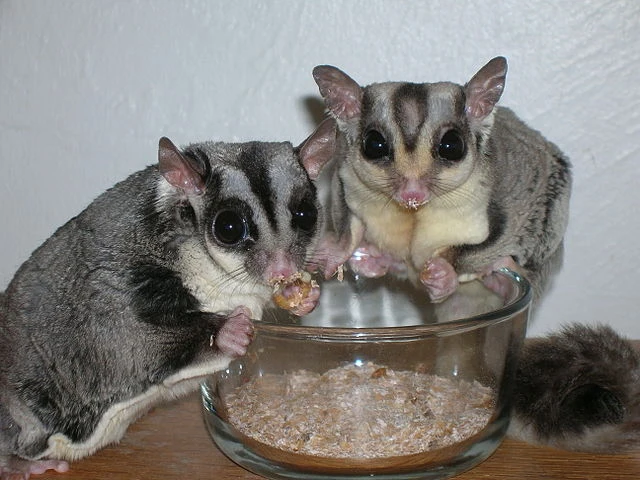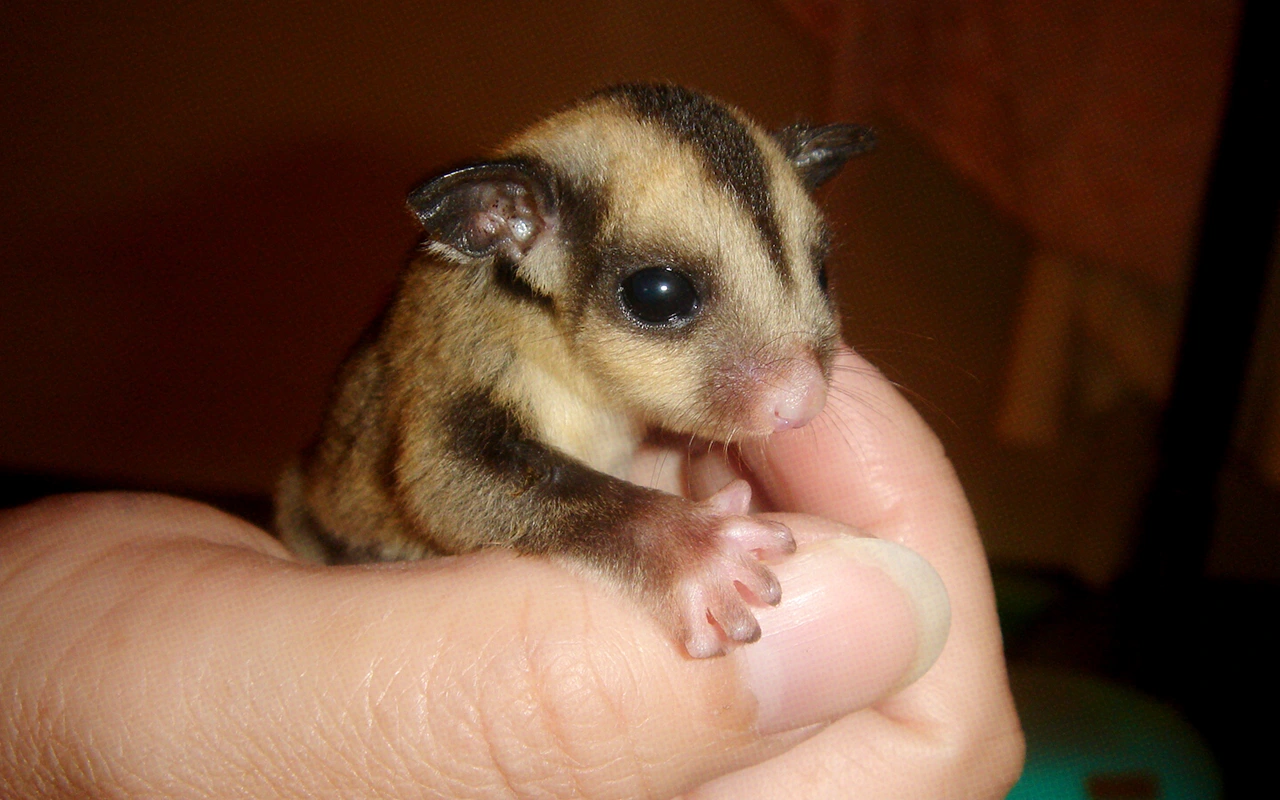Sugar gliders are small, social animals known for their playful and affectionate nature — and they are fast rising in popularity among pet enthusiasts and owners. But just before you run off to get one, or if you’ve gotten one newly, you need to know how to care for them, because these animals require specific care and attention to thrive in a domestic environment. In this comprehensive guide, we will cover everything you need to know to provide the best care for your sugar glider.
About This Species
Common Name: Sugar Gliders
Scientific Name: Petaurus breviceps
Adult Size: About 8 to 12 inches long, weighing 0.2 – 0.33 pounds
Lifespan: 10-12 Years
How To Care Properly For Your Glider
To properly care for your sugar glider, there are several essential factors that must be met. These include providing the appropriate housing, a balanced diet and proper nutrition, exercise, good hygiene, and monitoring their health for any issues. Okay, got it? You locked in? Let’s break it down further!
1. Housing
Sugar gliders require a spacious and safe environment to live in. A cage that is at least 24 inches wide, 24 inches deep, and 36 inches tall is recommended for one or two sugar gliders. The cage should have multiple levels, as sugar gliders love to climb and explore. It should also have a solid floor and be lined with a safe bedding material, such as shredded paper or aspen shavings.
The cage should be placed in a quiet area of your home, away from direct sunlight. Sugar gliders are sensitive to temperature changes, so it is important to maintain a consistent temperature between 70-90 degrees Fahrenheit.
Here are some of the most common types of housing for sugar gliders:
Cage: A cage is the most common type of housing for sugar gliders. As mentioned earlier, the cage should be at least 24 inches wide, 24 inches deep, and 36 inches tall. It should have multiple levels, as sugar gliders love to climb and explore.
Aviary: An aviary is a large enclosure that is designed for birds, but can also be used for sugar gliders. An aviary can provide more space and opportunities for exercise and exploration than a traditional cage. However, it’s important to make sure that the aviary is secure and escape-proof, as sugar gliders are skilled climbers and can easily escape if given the chance.
Tent: A portable and temporary housing option for sugar gliders. Tents are often used for bonding and playtime, as they provide a safe and enclosed space for your sugar glider to play and explore.
2. Diet

Sugar gliders are omnivores and require a balanced diet that includes both animal protein and fresh fruits and vegetables. Here’s a closer look at some of the key components of their diet:
Commercial diet: A high-quality commercial diet that is specifically formulated for sugar gliders should make up the majority of your sugar glider’s diet. Look for a diet that is high in protein and low in sugar. Some popular brands of sugar glider food include The Pet Glider and Exotic Nutrition.
Fresh fruits and vegetables: Fresh fruits and vegetables should make up a small portion of your sugar glider’s diet. Good options include apples, bananas, carrots, kale, and spinach.
Insects: Insects are an important source of protein for sugar gliders. Good options include crickets, mealworms, and waxworms. We recommend feeding your sugar glider insects that are raised specifically for pet consumption.
Treats: Treats should be given sparingly, as they are usually way too high in sugar. Good options include dried fruit, yogurt drops, and mealworms.
Fresh Water: It is important to provide your sugar glider with fresh water daily. It should be provided in a sipper bottle, as sugar gliders can accidentally drown in a water dish.
3. Exercise

Sugar gliders are active animals that require daily exercise and mental stimulation. They love to climb, jump, and play, so it is important to provide them with plenty of opportunities to do so. Some ways to provide exercise and enrichment for your sugar glider include:
Climbing structures: Sugar gliders love to climb and explore, so providing them with climbing structures is a great way to keep them active and engaged. Good options include branches, ropes, and ladders.
Puzzle feeders: Puzzle feeders are toys that require your sugar glider to work for their food. These toys can help keep your sugar glider mentally stimulated and prevent boredom. Good options include foraging balls and cubes.
Hanging toys: Hanging toys can provide your sugar glider with a fun and interactive play experience. Good options include hanging balls, hammocks, and swings.
Bonding pouch: A bonding pouch is a soft, fleece-lined pouch that you can wear around your neck or waist. These pouches allow your sugar glider to snuggle up close to you while you go about your day, which can help strengthen your bond with your pet.
4. Socialization

Sugar gliders are social animals that require daily interaction with their owners or other sugar gliders. They thrive on attention and affection, so it is important to spend time bonding with your pet.
Some ways to bond with your sugar glider include:
- Holding and cuddling your sugar glider daily
- Talking to your sugar glider in a soft and soothing voice
- Offering treats and rewards for good behavior
- Allowing your sugar glider to sleep in a bonding pouch, which can help strengthen your bond
5. Health Care
Sugar gliders require regular veterinary care to maintain their health and well-being. It is recommended to take your sugar glider to an exotic animal veterinarian, at least once a year for a check-up.
Some signs that your sugar glider may be in poor health include:
- Loss of appetite
- Lethargy or lack of energy
- Diarrhea or loose stools
- Difficulty breathing or wheezing
If you notice any of these signs, it is important to seek veterinary care immediately.
6. Health Challenges
Like all animals, sugar gliders are susceptible to a variety of health challenges. Here are some common health issues to watch for:
- Malnutrition: A diet that is lacking in essential nutrients can lead to a variety of health problems in sugar gliders. Be sure to provide your sugar glider with a balanced diet that includes a variety of foods.
- Dental problems: Sugar gliders have constantly growing teeth, which can lead to dental problems if their diet is not balanced or if they do not have access to appropriate chewing materials.
- Parasites: Sugar gliders can be susceptible to a variety of parasites, including fleas, ticks, and mites. Regular check-ups with a veterinarian can help ensure that your sugar glider stays healthy and parasite-free.
- Stress-related illnesses: Sugar gliders are social animals that require plenty of interaction and playtime. If they are kept in isolation or in a stressful environment, they can develop stress-related illnesses such as depression, and in extreme cases, self-mutilation.
7. Bathing and Cleaning
Sugar gliders are generally clean animals that groom themselves regularly. Despite this, you still need to provide them with a clean and hygienic living environment. Here are some tips for keeping your sugar glider clean:
- Spot clean daily: Clean up any waste or food debris from your sugar glider’s cage or play area on a daily basis.
- Deep clean weekly: Once a week, remove all toys, bedding, and accessories from your sugar glider’s cage and thoroughly clean the cage with a pet-safe disinfectant. Rinse everything well and allow it to dry completely before putting everything back in the cage.
- Bathing: Sugar gliders do not require regular baths, as they are able to groom themselves effectively. However, if your sugar glider gets into something sticky or dirty, you can give them a shallow bath in a sink or tub filled with warm water. Use a pet-safe shampoo and be sure to rinse your sugar glider thoroughly.
7. Dealing with Odour
Sugar gliders have a distinctive musky odor that some people may find unpleasant. Here are some tips for dealing with odor:
- Clean regularly: Keeping your sugar glider’s cage and play area clean can help reduce odor.
- Use a pet-safe deodorizer: There are a variety of pet-safe deodorizers available that can help reduce odor in your sugar glider’s living space.
- Consider neutering: The male sugar gliders have a stronger musky smell. Neutering them can help reduce this odour. If you’re looking for more tips on how to deal with this, we have a full, in-depth post that tackles how to handle your sugar glider’s odour.
Final Thoughts
Caring for a sugar glider requires time, effort, and attention to detail. You need to provide them with a safe and stimulating environment, a balanced diet, regular exercise and socialization, and routine health checks. Doing all this will ensure your sugar glider lives a happy and fulfilled life.
Happy parenting!
